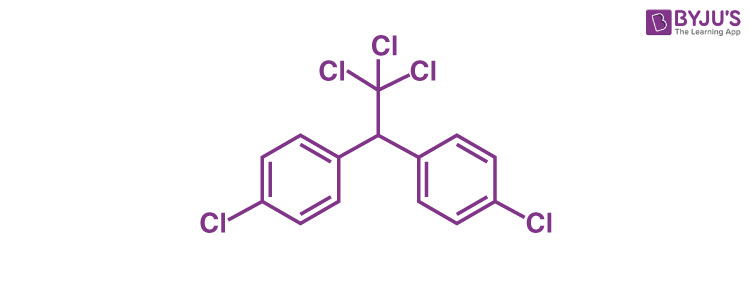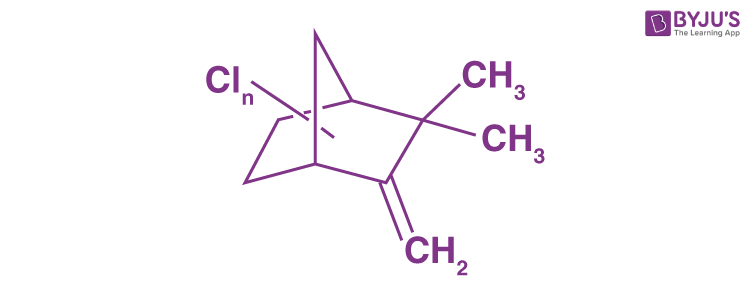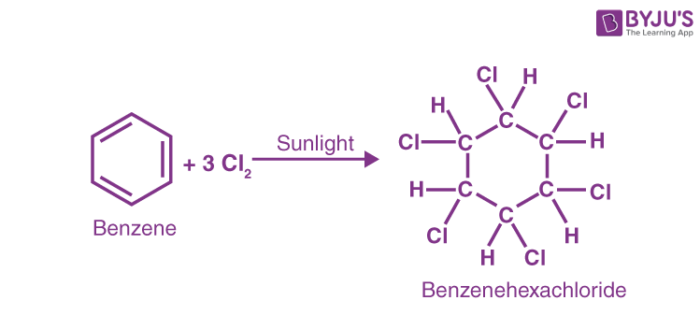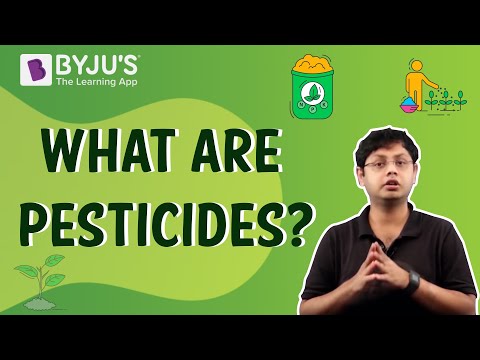Pesticides are not new discoveries. Pesticides were used by many ancient civilizations to protect their crops from insects and pests. Nowadays, pesticides are used all over the world and increase crop yield by 30% on average while also improving crop quality. Pesticides are used so frequently that the term pesticide is frequently used interchangeably with plant protection products.
| Definition: A pesticide is a chemical agent that is used to kill or control pests. |
Pesticides Chemistry Questions with Solutions
Q-1: Name the synthetic chemical that was the first to be used as a pesticide? Give its IUPAC name and structure as well.
Answer: DDT
Explanation: DDT was used in agriculture to protect cotton, deciduous fruits, cereals, and potatoes from pests. DDT’s widespread use in crop protection aided the Green Revolution and paved the way in the era of chemical pesticides.
The IUPAC name of DDT is 1,1,1-trichloro-2,2-bis[4-chlorophenyl]ethane.
The structure is shown below:

Q-2: In pesticide, the root word is latin word “cide” which means
- To harm
- To control
- To kill
- To suicide
Answer: c) to kill
Q-3: Which of the following is not a pesticide?
- Boric acid
- Allethrin
- Rozol
- Alprazolam
Answer: d) Alprazolam
Explanation: Alprazolam is a tranquilizer that is used to treat anxiety and panic attacks.
Q-4: The most commonly used pesticide toxaphene is
- Carbamate
- Organophosphate
- Organochlorine
- Antibiotic
Answer: c) Organochlorine
Explanation: Organochlorine is a group of pesticides or other synthetic organic compounds which contain chlorine.

Toxaphene’s structure clearly shows that it contains chlorine, making it an organochlorine pesticide.
Q-5: Pyrethrum, a naturally occurring pesticide is derived from
- Crocus
- Daffodil
- Chrysanthemum
- Butter cup
Answer: c) Chrysanthemum
Q-6: Give one word for the following
- A chemical used to kill mice and rats
- Synthetic version of pyrethrin pesticide
- A sulfonylurea herbicide
- Class name of pentachlorophenol pesticide
- A nematocide kills
Answers:
- Rodenticides
- Pyrethroid
- Nicosulfuron
- Fungicide
- Nematode worms
Q-7: How are pesticides harmful to the environment and human beings?
Answer:
Impact on Humans
Pesticides’ effects on human health are determined by the toxicity of the chemical as well as the length and magnitude of exposure. Pesticides cause a variety of human health risks, ranging from short-term effects like headaches, stinging eyes, diarrhea and nausea to long-term effects like cancer and reproductive harm and birth defects.
Impact on environment
Pesticides leach into soils and groundwater, where they can contaminate drinking water,and pollute the air.
Pesticides found in soil impede nitrogen fixation, which is required for the growth of many large plants. Crop yields may suffer as a result of this. Pesticides applied to blooming crops can kill honeybees, which serve as pollinators. This reduces crop pollination and reproduction as well.
Q-8: Carbamate have the same mode of action as __________
Answer: The mechanism of action of insecticidal carbamates is the same as that of organophosphates, namely inhibition of the enzyme cholinesterase. They both affect the nervous system by interfering with an enzyme cholinesterase that regulates neurotransmitters.
Q-9: DDE, a insecticide is a acronym for
a) Dichlorodiphenyldichloroethylene
b) Dibromodiphenyldichloroethylene
c) Dichlorodiphenyldichloroethenyl
d) Dibromodiphenyldichloroethenyl
Answer: a) Dichlorodiphenyldichloroethylene
Q-10: The active ingredient present in Baygon is
- Transfluthrin
- Malathion
- Carbofuran
- Aldicarb
Answer: a) Transfluthrin
Explanation: Baygon is an insecticide that is used to exterminate and control household pests such as crickets, cockroaches, termites, carpenter ants, spiders, silverfish, and mosquitoes.
Baygon products contain the active ingredients pyrethroids cyfluthrin, transfluthrin, carbamate propoxur, and organophosphorus chlorpyrifos.
Q-11: DDT is
- Biodegradable
- Non biodegradable
- Growth enhancer
- Tranquilizer
Answer: b) Non biodegradable
Explanation:
DDT is a non-biodegradable pesticide because it cannot be degraded by microbes.As a result, it is capable of having a negative impact on the environment.
Q-12: The most commonly used pesticide is benzene hexachloride(BHC). It belongs to the
- Organophosphates
- Triazine
- Organochlorine
- Carbamate
Answer: c) Organochlorine
Explanation: BHC is a non-specific, highly toxic insecticide.
It is classified as an organochlorine because it contains chlorine in its structure.
Q-13: How can you prepare BHC from benzene?
Answer: BHC is an abbreviation for benzene hexachloride or 1,2,3,4,5,6-hexachlorocyclohexane. It is made by adding chlorine to benzene in the presence of light.
The following reaction occurs:

Q-14: Name the pesticide that is most commonly used to protect wooden structures from termite attack.
Answer: Aldrin is a organochlorine pesticide that kills soil insects like termites, corn rootworms, wireworms, rice water weevils, and grasshoppers. It has been widely used to protect crops such as corn and potatoes, as well as to keep termites away from wooden structures.
Q-15: Pesticides are harmful to human beings as they attack on
- Muscular system
- Nervous system
- Respiratory system
- No effect
Answer: b) and c)
Practise Questions on Pesticides
Q-1: Aldicarb is the chemical present in
- Aldrin
- Endrin
- Temik
- DDT
Q-2: A propoxur is a
- Herbicide
- Insecticide
- Bactericides
- Larvicides
Q-3: The gas responsible for the Bhopal gas tragedy was methyl isocyanate. This gas serves as an intermediate chemical in the production of carbamate insecticide
- Chlordane
- Methomyl
- Aldicarb
- None of the above
Q-4: What are the most common household pesticides?
Q-5: Bordeaux mixture is mixture of
- Copper sulphate + quicklime
- Copper sulphate + slaked lime
- Milk of magnesia + quicklime
- Milk of magnesia + slaked lime
Click the PDF to check the answers for Practice Questions.
Download PDF
Recommended Videos
Pesticides – Uses, Disadvantages, and Advantages

Comments